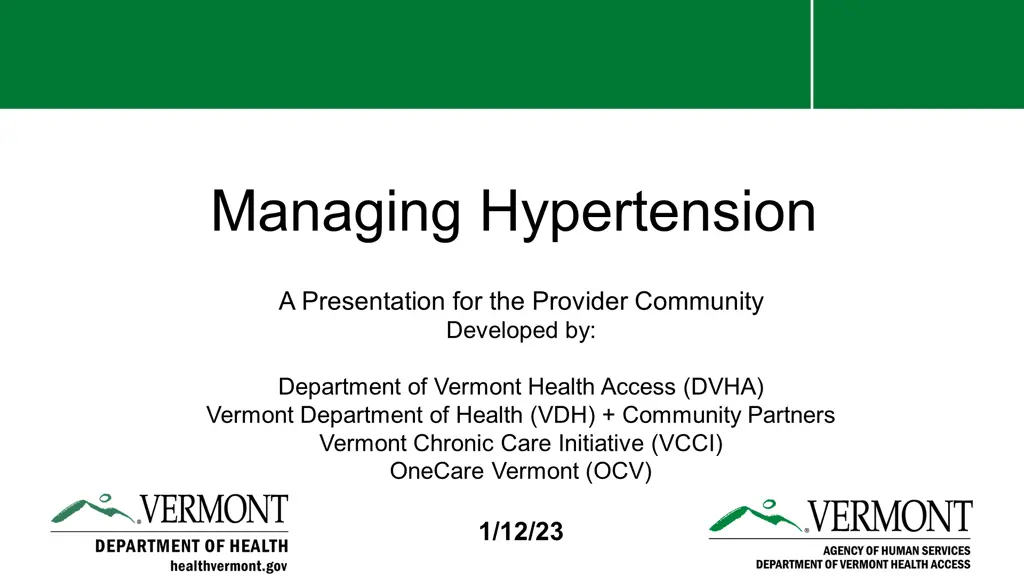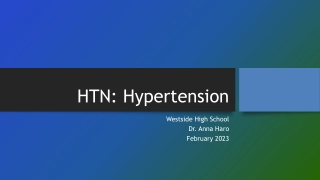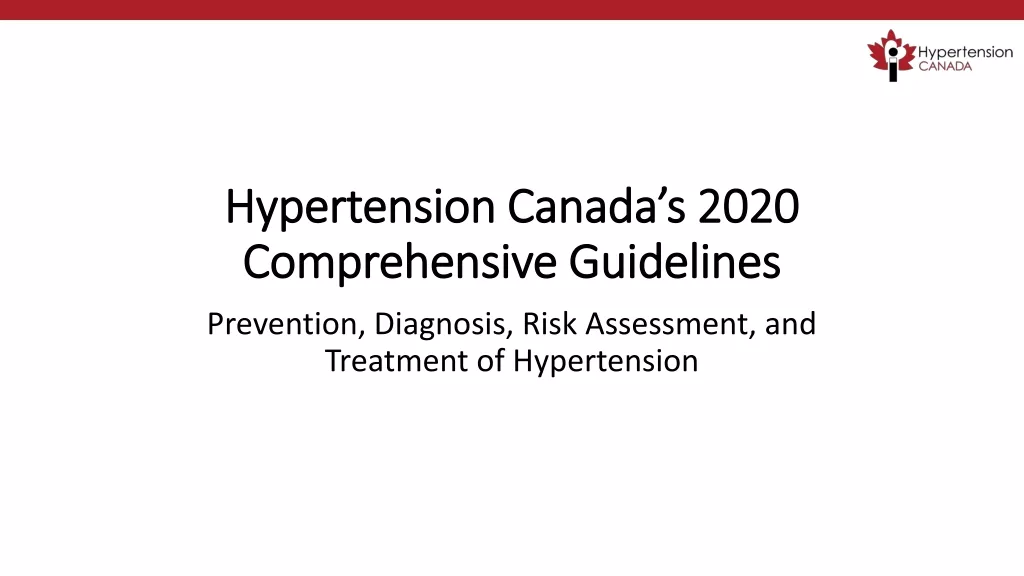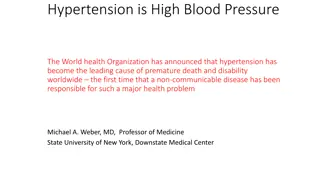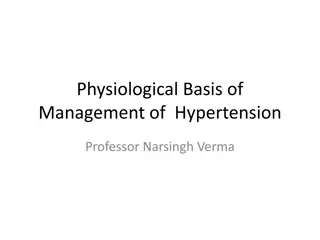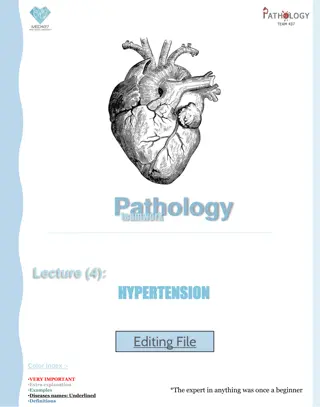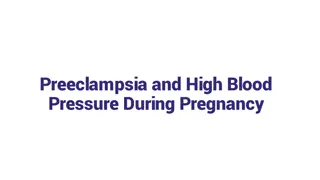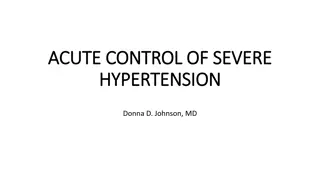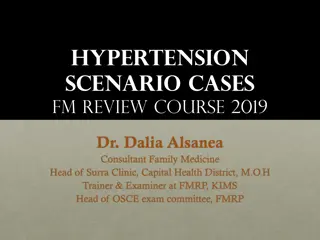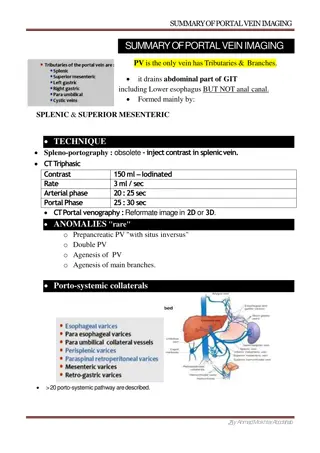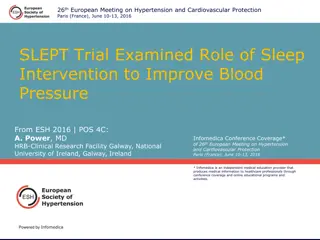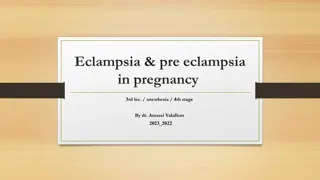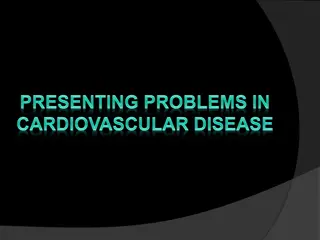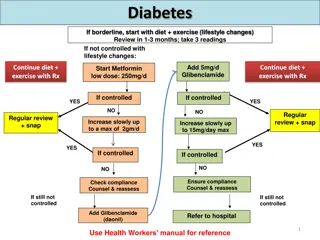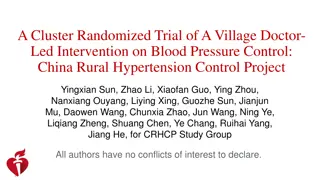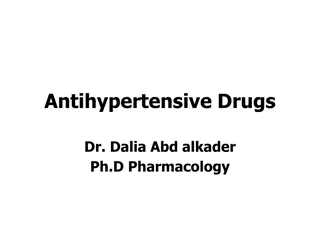Managing Hypertension
Managing hypertension, which covers health inequities, performance measurement, self-monitoring blood pressure programs, and innovative approaches for improving blood pressure control.
Download Presentation

Please find below an Image/Link to download the presentation.
The content on the website is provided AS IS for your information and personal use only. It may not be sold, licensed, or shared on other websites without obtaining consent from the author.If you encounter any issues during the download, it is possible that the publisher has removed the file from their server.
You are allowed to download the files provided on this website for personal or commercial use, subject to the condition that they are used lawfully. All files are the property of their respective owners.
The content on the website is provided AS IS for your information and personal use only. It may not be sold, licensed, or shared on other websites without obtaining consent from the author.
E N D
Presentation Transcript
Managing Hypertension A Presentation for the Provider Community Developed by: Department of Vermont Health Access (DVHA) Vermont Department of Health (VDH) + Community Partners Vermont Chronic Care Initiative (VCCI) OneCare Vermont (OCV) 1/12/23
What We'll Cover 2 Health inequities that influence hypertension control Performance measurement and monitoring for hypertension control The purpose and core elements of developing a self-monitoring blood pressure program (SMBP) within your practice Prescription for home-use blood pressure monitors and cuffs for patients with cost barriers (examples of completed forms will be provided) Innovative approaches that local practices are implementing to improve blood pressure control Locating resources on this topic
Learning Objectives 3 Following today's webinar, you will be able to: 1) Identify several health inequities that influence hypertension 2) Summarize the key performance measurement strategy for hypertension control 3) Examine opportunities to include a self-monitoring blood pressure program (SMBP) within your practice 4) Use prescription to provide home-use blood pressure monitor + cuff to patients for whom cost is a barrier
4 Hypertension in Vermont Hypertension in Vermont Paul Meddaugh, Heart Disease & Diabetes Epidemiologist Vermont Department of Health
Vermont Hypertension Prevalence 5 The Vermont hypertension prevalence has remained statistically similar since 2011. Vermont United States 30% 30% 29% 30% 30% 27% 26% 27% 25% 26% 25% 25% 2011 2013 2015 2017 2018 2019 2020 Source: Behavior Risk Factor Surveillance System (BRFSS), 2011-2020.
Health Inequities and Hypertension 6 37% 30% 24% 22% Hypertension is significantly more likely among adults: With any disability. With poor mental health. Living at a low or middle SES compared to a high SES. Living in a small rural town compared to an urban one. Any No Yes Poor Mental Health No Disability 27% 27% 25% 24% LGBTQ+ Non-LGBTQ+ Vermonters of Color White, Non-Hispanic Race/Ethnicity Sexual Orientation/Gender Identity 33% 30% 27% 27% 24% 22% 21% Source: VT Behavior Risk Factor Surveillance System (BRFSS), 2020. Low Middle High Isolated Small Rural Small Rural Micropolitan Urban Socioeconomic Status (SES) Geographic Isolation
7 Vermont Hypertension Primary Care Visits The rate of primary care visits for hypertension among insured Vermonters has trended down since 2018. Rate of Primary Care Visits per 1,000 Insured Vermonters * 375.0 376.8 350.9 332.5 285.9 278.6 259.7 259.5 249.7 223.6 2011 2012 2013 2014 2015 2016 2017 2018 2019 2020 Source: GMCB Vermont Health Care Uniform Reporting and Evaluation System (VHCURES), 2011-2020 extract 3005 extracted 10/25/22. *Comparisons 2015 and earlier to post-2015 should be made with caution due to changes in the number of private payers submitting to VHUCRES beginning in 2016. All analyses, conclusions, and recommendations provided here are solely those of the Department of Health and not necessarily those of the GMCB.
Hypertension-Related Mortality 8 The rate of all hypertension-related deaths among Vermonters is significantly higher than hypertension as the primary (principal) cause for death. This indicates that the burden of hypertension is as a contributing factor to disease. Mortality Rate per 100,000 Vermonters 259.8 226.1 228.6 228.5 222.2 205.6 208.6 190.4 191.5 175.8 178.8 41.0 39.2 36.2 32.9 33.4 28.3 25.5 29.8 20.8 24.6 19.6 2010 2011 2012 2013 2014 2015 2016 2017 2018 2019 2020 Source: VT Vital Statistics, 2010-2020.
Self-Measured Blood Pressure Monitoring Programs (SMBPs) 9 Implementation of SMBPs have increased at VDH partnering health centers from 2020-2022. 100% 75% 100% Blood pressure monitor loaner libraries have increased over time among health centers with an SMBP. 89% 78% 67% 2020* 2022 2021 Proportion of Partnering Health Centers with an SMBP Source: Vermont Health Systems Quality Improvement Assessment (VHSQIA), 2020-2022. *In 2020, fewer (N = 6) health centers were working on heart disease prevention strategies than in subsequent years (N = 8, 2021 and 2022), as a result, this value reflects only those working on heart disease strategies in 2020.
10 A Closer Look: Vermont Medicaid The blue line shows the percentage of Vermont Medicaid members 18-85 years of age who had a diagnosis of hypertension and whose blood pressure was adequately controlled (<140/90mm Hg) during the previous year. The red dotted line displays the national 50th percentile for Medicaid programs. The blue line is Vermont's actual performance.
HBPM & Measuring Performance 11 Home Blood Pressure Monitoring Now Part of Annual CBP Performance Measure Starting in 2021, the NCQA revised the HEDIS measure on Controlling High Blood Pressure to include remote blood pressure monitoring readings This underlines the importance of encouraging the use of home blood pressure monitors and documenting those readings during telehealth visits and other patient transmissions or encounters Remote Blood pressure readings done at home can be captured during a follow-up in- person office visit, telehealth visit, telephone visits, e-visit, or virtual visit. Patient-reported readings taken with a digital device are acceptable and should be documented in the medical record along with the date. Providers don t need to see the reading on the digital device; the patient can verbally report it This information, and more, can be found on the Hypertension Provider & Patient Tip Sheet
Project Work: Interventions so far Our project strategies have revolved around: making automatic blood pressure devices with cuffs more accessible and affordable Expanded ICD-10 diagnosis codes (clinical criteria) encouraging patients to join educational workshops that promote the importance of self-monitoring BPs www.MyHealthyVT.org raising awareness among providers about measuring, diagnosing and documenting these BP reading in patient charts Developed a Provider/Patient Tip sheet (click here) 12
Clinical Checklist 13 Send Progress Note to support diagnosis and need for frequent monitoring (clinical criteria) Send prescription with diagnosis of XXX, prescription: automatic BP device with cuff (and specify if small or extra-large is needed), quantity #1 Send completed DME form
14 Clinical Slide Prescription Example Prescription should include: Diagnosis with ICD 10 code Sig: Automatic blood pressure device with cuff. Include directions. If larger or small cuff indicated please sure to ensure include in prescription ie, Auto BP cuff with X large cuff. (Avg size cuff 9 to17 in circumference.)
Cuff Sizes 15 *Bladder and cuff size may differ by manufacturer. Source: Table 3: Muntner P, Shimbo D, Carey RM, Charleston JB, et al. Measurement of blood pressure in humans: a scientific statement from the American Heart Association. Hypertension. 2019;73:e35 e66. doi: 10.1161/ HYP.000000000000008.
DME Form 16 The ordering provider must document a description of the device and/or its HCPCs code. If the ordering provider does not provide the HCPCs code, the DME supplier must provide the HCPCs code for all prior authorizations and on all claims, on this form or on other documentation submitted to the DVHA and DXC. The codes submitted to DVHA and DXC must match the description documented by the ordering provider.
17 Core Elements of an SMBP Program Practice Practice Protocol: Implement a protocol with a defined workflow, patient eligibility, and action steps. Prepare Prepare Team for engagement: identify team members, standardize training, establish buy-in Determine Determine Clinical support system: Use an existing model, establish a feedback loop, ensure IT components are in place https://millionhearts.hhs.gov/files/MH_SMBP_Clinicians.pdf
18 Core Elements of a SMBP Program cont. Empower Patients: Explain the process and train patients on the correct technique Include written guidance and a link or video in the patient portal Establish the easiest and most hassle-free process to get an SMBP unit to patients Tracking method for patients (online / paper/ etc.) Establish a reliable process to get SMBP values back into EMR Work with billing /coding to maximize reimbursement and minimize patient costs https://millionhearts.hhs.gov/files/MH_SMBP_Clinicians.pdf
19 Clinical Flow https://millionhearts.hhs.gov/files/MH_SMBP_Clinicians.pdf
NOTCH: Issuing and Tracking 20 Issuing and Tracking SMBP devices: Complete device loaner agreement, scan copy into patient s chart SMBP-Loan (or generate from patient chart and have electronically sign) and give patient a copy Create a ToDo in the patient s chart and assign the user as the clinic s nurse triage account Assign reason as SMBP (allows a way to track patients that are participants in SMBP program) Set ToDo date for return date as discussed with the patient (4 weeks)
NOTCH: Data Collection 21 1. Using a smartphone app linked to the SMBP device the patient can send home BP reading to a specified NOTCH email. (These emails are received by care coordination, saved as a pdf in the EHR labeled SMBP pt scanned data and then routed to the provider. The document can be tracked using a DM/HM report in Medent. BP results are entered into the vital section of patient s chart) 2. Using the patient portal, the patient can enter the home BP readings and send directly to their clinic. Nursing should accept the data and it will automatically be entered as data into the patient s vitals record. 3. Patient can schedule a 28-day BP check with nursing, at time of receiving SMBP device, if no future appointments are scheduled with their provider. Patients are asked to bring BP readings to follow up appointment or drop them off at office in a specified time. These readings are entered into chart. All appointment types can be tracked and extrapolated in a report. 4. Provide a pre-stamped envelope and form to complete to send results back. A document is created in Medent titled BP readings which, once created and closed, can be tracked through Medent reporting.
NOTCH: Using EHR to Follow Up 22 EHR Reports: Identify participation Differentiate BPs readings in office versus at home Identifying patients with dx of HTN and not seen in office in past 6 months Identify participants of program who have not been seen or provided BP readings Identify patients who are due to return device Current Data: 800 patients have enrolled Over 4880 have been offered (either have home BP device or declined to participate)
Prescribing Blood Pressure Cuffs Prescriptions for BP cuffs need to be filled at a medical supply store and require a DME Only one store in Chittenden County will currently fill /bill Medicaid
Blood Pressure Cuff Lending Libraries Started at Champlain Islands site due to lack of pharmacies, lack of insurance coverage Expanded to other sites based on interest/need/capacity Currently we have lending libraries at two sites and for two specific populations; those receiving home care and pregnant patients Variation in how programs were implemented across sites; attempting to standardize while keeping implementation barriers low Use of EHR med module to prescribe in-house cuffs Development of organization-wide protocol to guide sites implementing a lending library
ResourceSlide 25 Clinical criteria Cuff size resource Gainwell rep link Measurement of Blood Pressure in Humans: A Scientific Statement From the American Heart Association | Hypertension (ahajournals.org) MyHealthyVT.org Provider & Patient Tip Sheet Self-Measured Blood Pressure Monitoring for Clinicians (Million Hearts)
Questions? 26 Primary Contacts: Erin Carmichael Director of Quality Management, DVHA, Erin.Carmichael@vermont.gov Rebecca O'Reilly, MS, RD Manager, Heart Disease and Diabetes Programs, VDH, Rebecca.OReilly@vermont.gov
